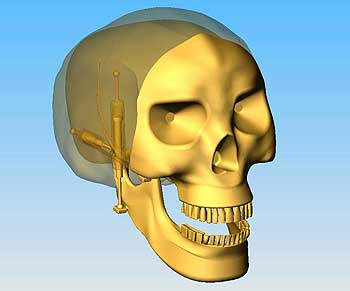Aug 2 2005
A robotic human jaw, under collaborative development by Massey engineers, will have applications for both medical and food technological research.

A team led by Dr John Bronlund and Associate Professor Peter Xu in the Institute of Engineering and Technology has been subcontracted by the University of Auckland to design and make a robotic jaw as part of a larger project in its Bioengineering Institute.
Associate Professor Andrew Pullan at the Auckland Institute is mathematically modelling the muscles of the human face to reproduce jaw movement through muscle contraction, but requires information about the mechanics of the jaw muscles, the forces used in chewing and biting.
The Massey team is now engaged in the construction of the robotic jaw, which will provide comprehensive data of the forces and movements applied in the chewing of food. during chewing of food. Post-graduate students have also been given the opportunity to work on the jaw, which is the first of its type in the world.
Masters student Jozsef-Sebastian Pap has designed the robot and the six actuators which drive the bottom jaw (the top half of the human jaw remains fixed). PhD student Jonathon Torrence is working on the control of the robot.The team estimates the first prototype robotic jaw is six months from completion.
Dr Xu says the project is an excellent example of multidisciplinary research – combining a very innovative type of mechatronics, food technology, and biomechanics. The project is also collaborative, originating from a visit to the University D'Auvergne Clermont in France in 1999. There, Dr Bronlund became interested in a project measuring the chewing behaviour of humans and has since been working with Dr Xu to replicate this in robots.
In New Zealand, Professor Jules Keiser at the University of Otago’s School of Dentistry has contributed data on the shape of the jaw and teeth. This information will be combined with research by Dr Kylie Foster at Massey’s Albany campus measuring the movement of the jaw as it chews, to provide a complete picture of the jaw in motion from which to base the robotic movement.
Dr Bronlund says the ability of the jaw to mechanically replicate the chewing actions of humans has applications across medicine and food technology. Dental researchers can use the jaw to study the response of dental implants to the chewing of different foods and to evaluate the impact of impaired dentition on chewing efficiency. The jaw is designed to be fitted with a variety of teeth, such as the sharp pointy teeth of a six year old or the blunter molars of an adult..
For the purposes of food technology, the jaw will be especially useful in the study of the dynamics of texture changes in foods during chewing. Dr Bronlund says robotic testing of this type will be very valuable when combined with sensory food evaluation techniques. . In the future it is intended to teach the robot to adaptively chew food. It may be made to make its own decisions on how to chew a new food product. If it loses a tooth, it will adjust its motion accordingly and the data collected, of chewing force and jaw movement, will reflect the changed situation.